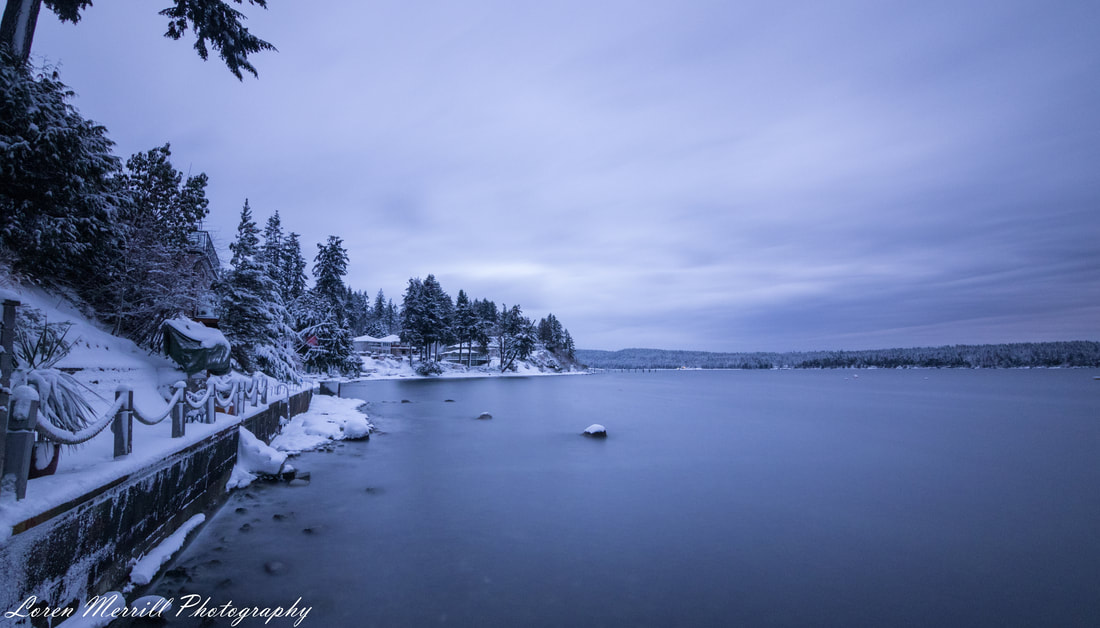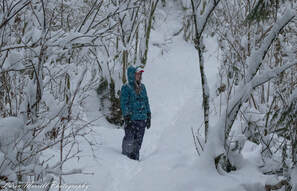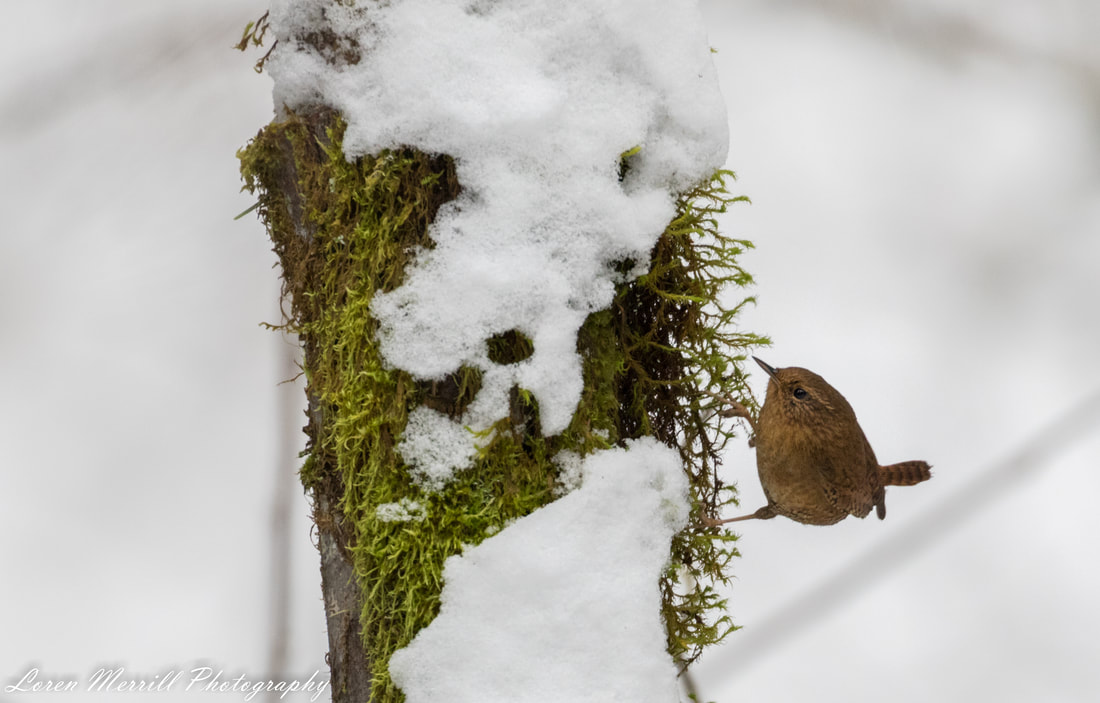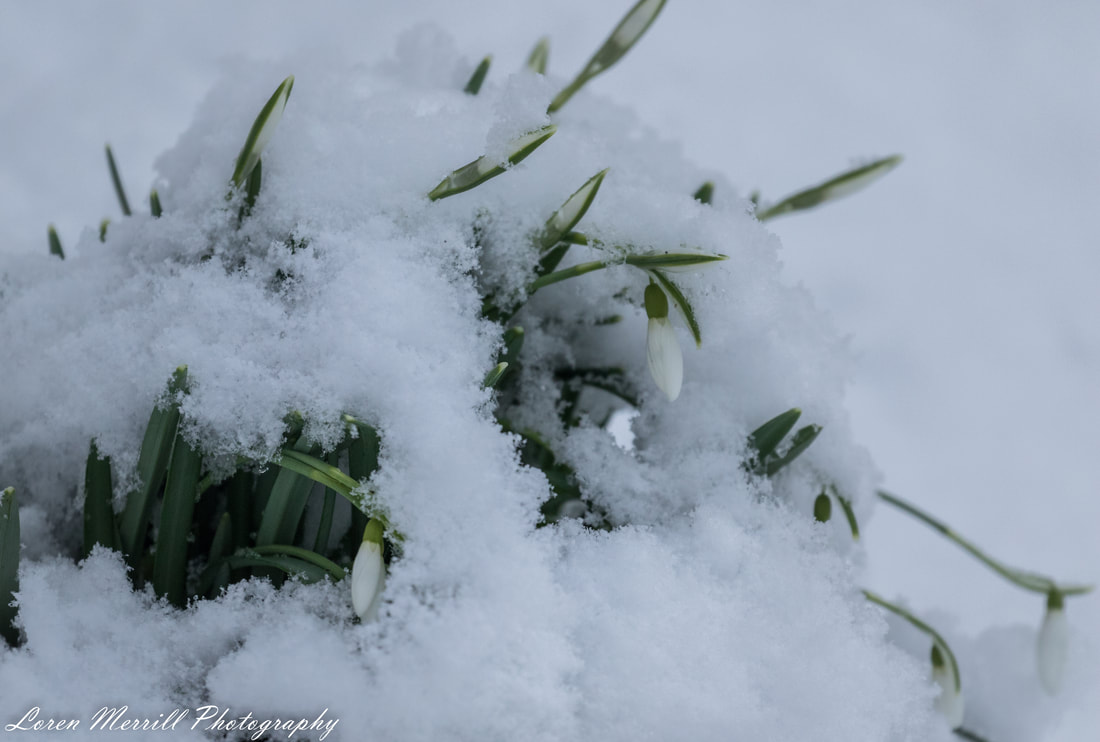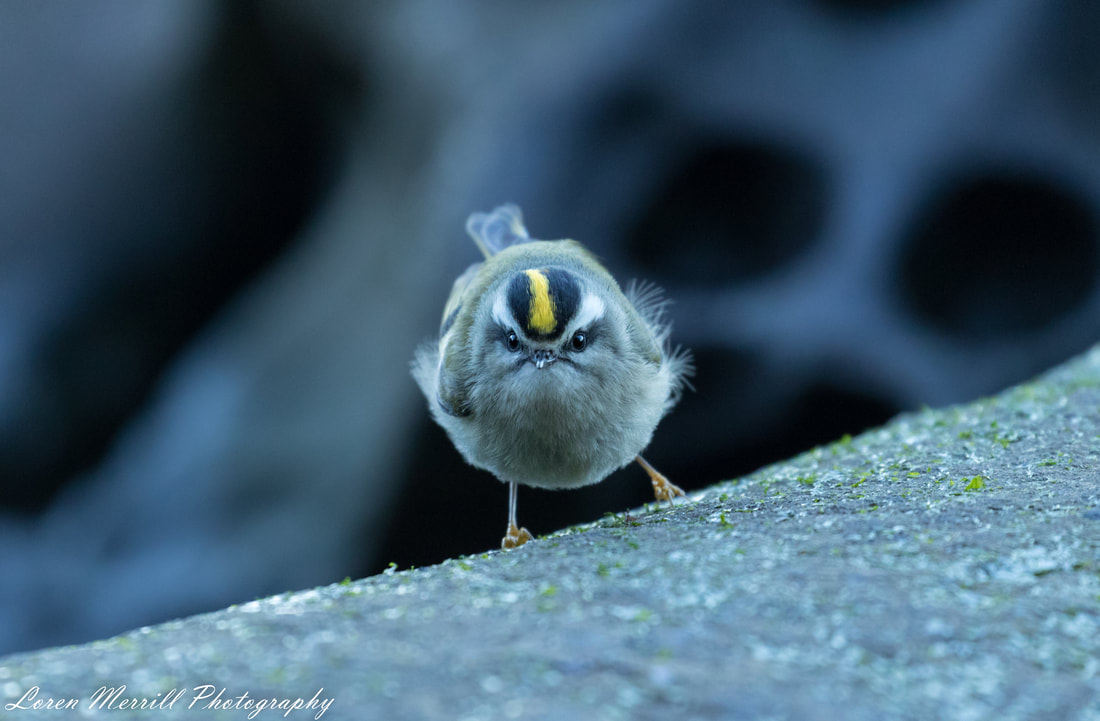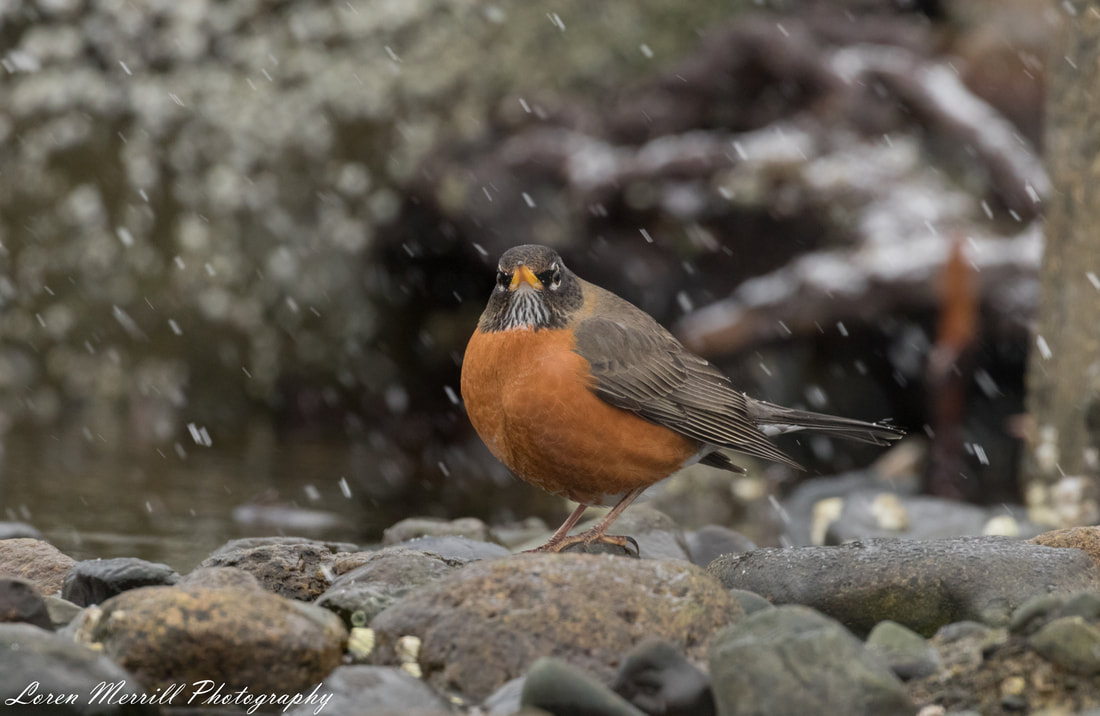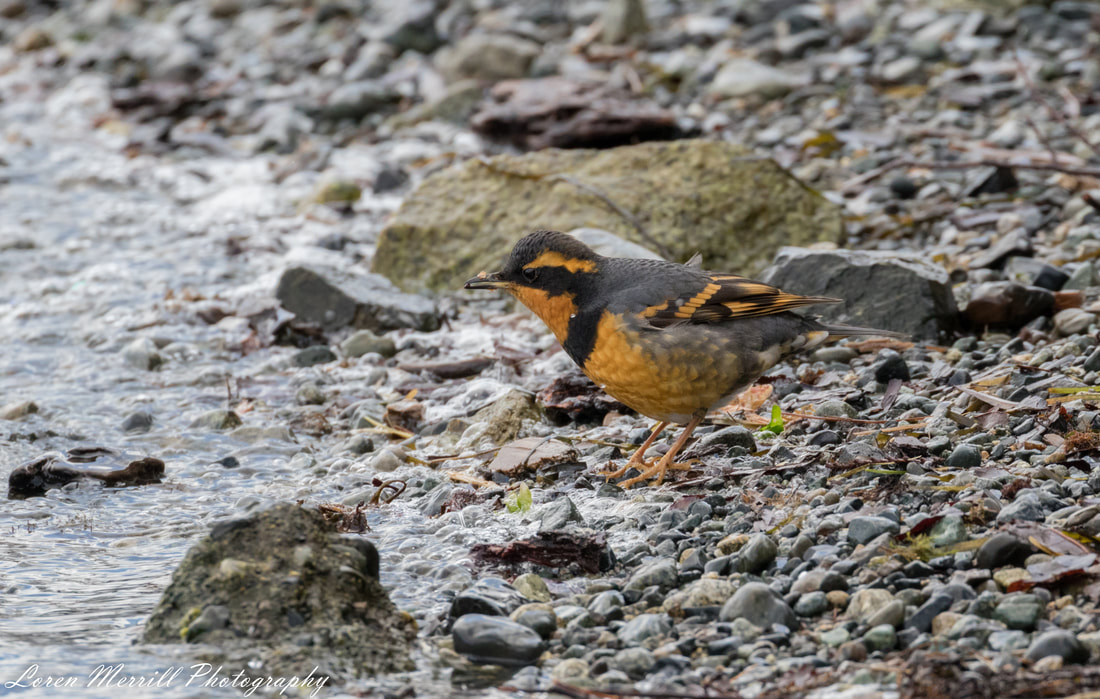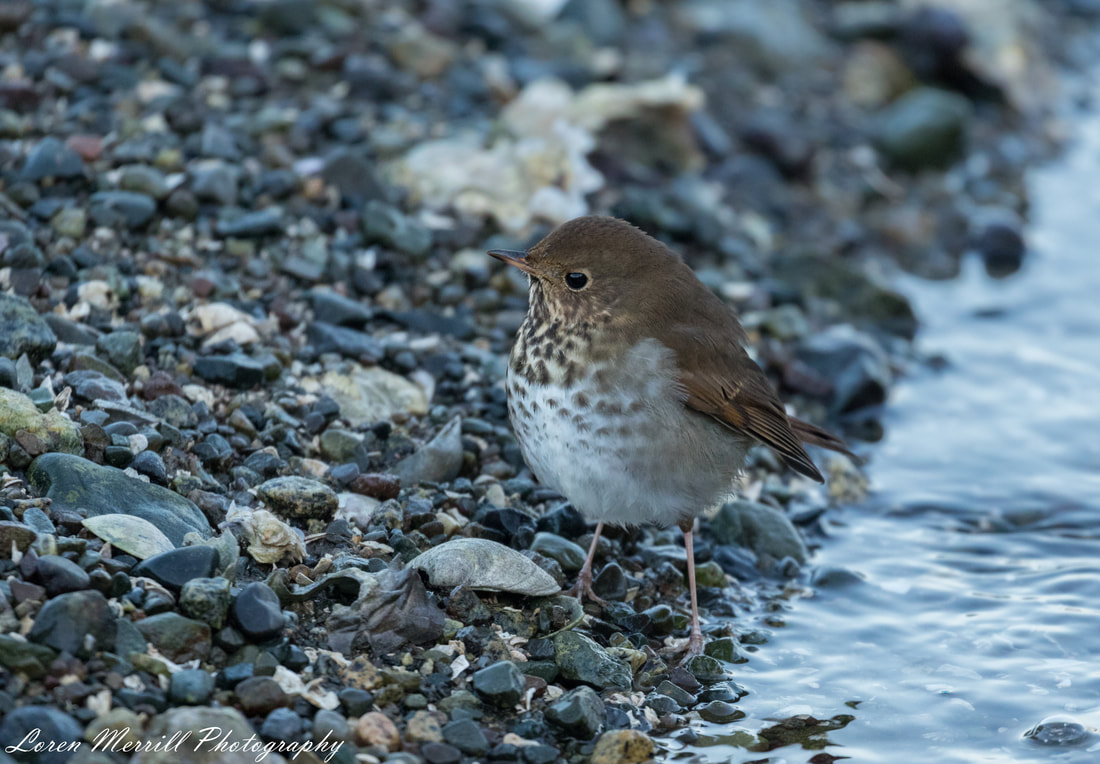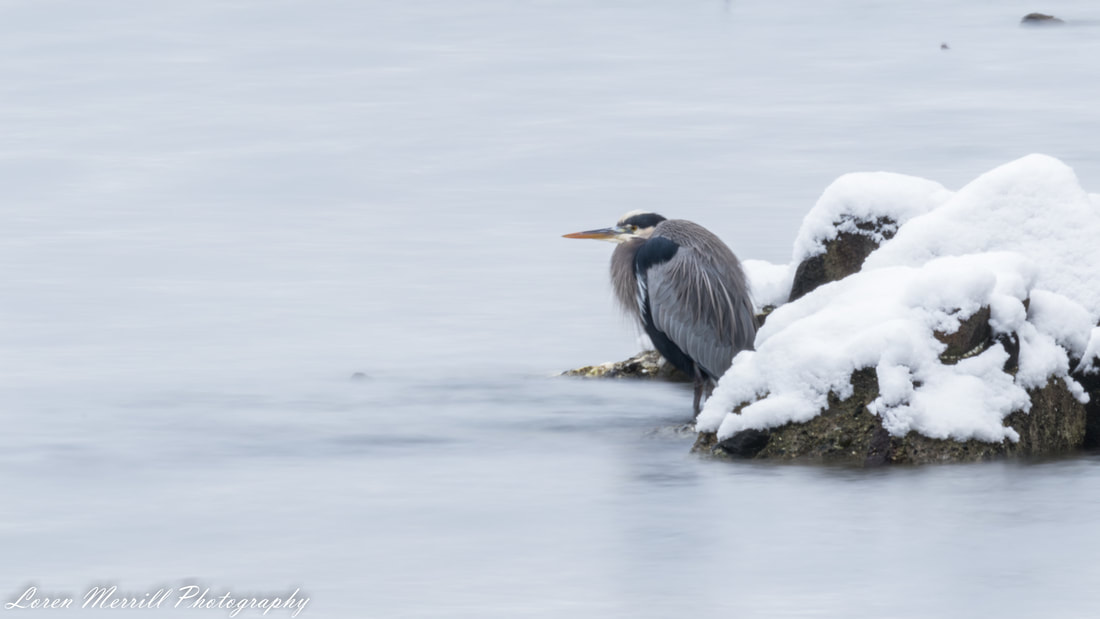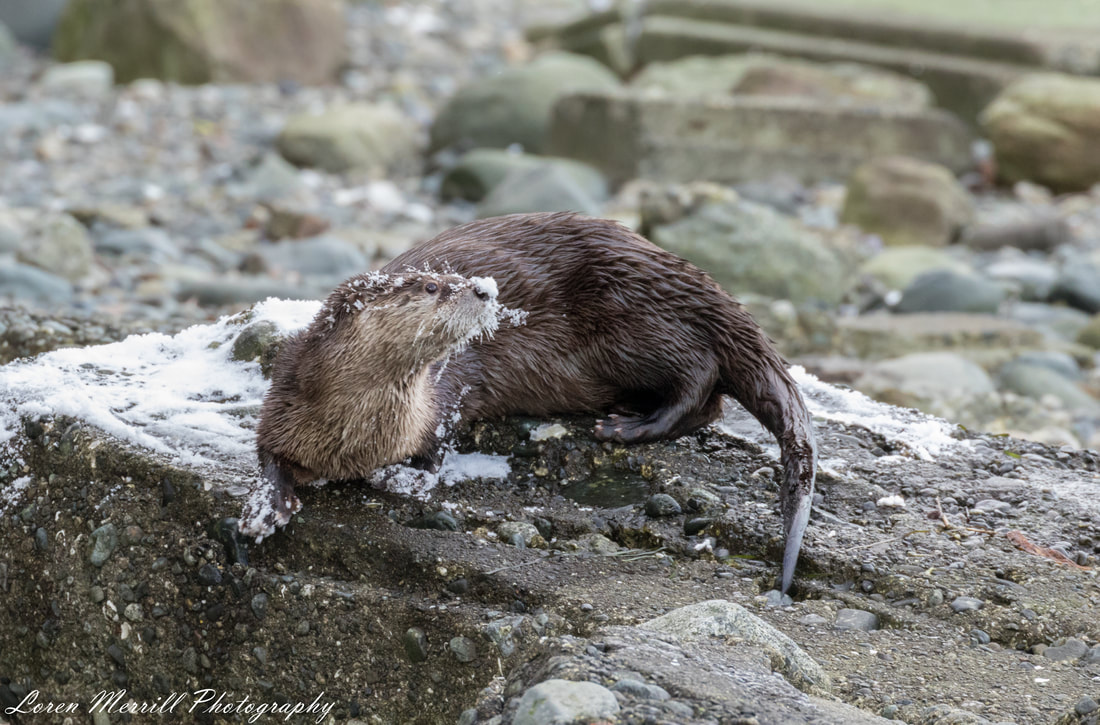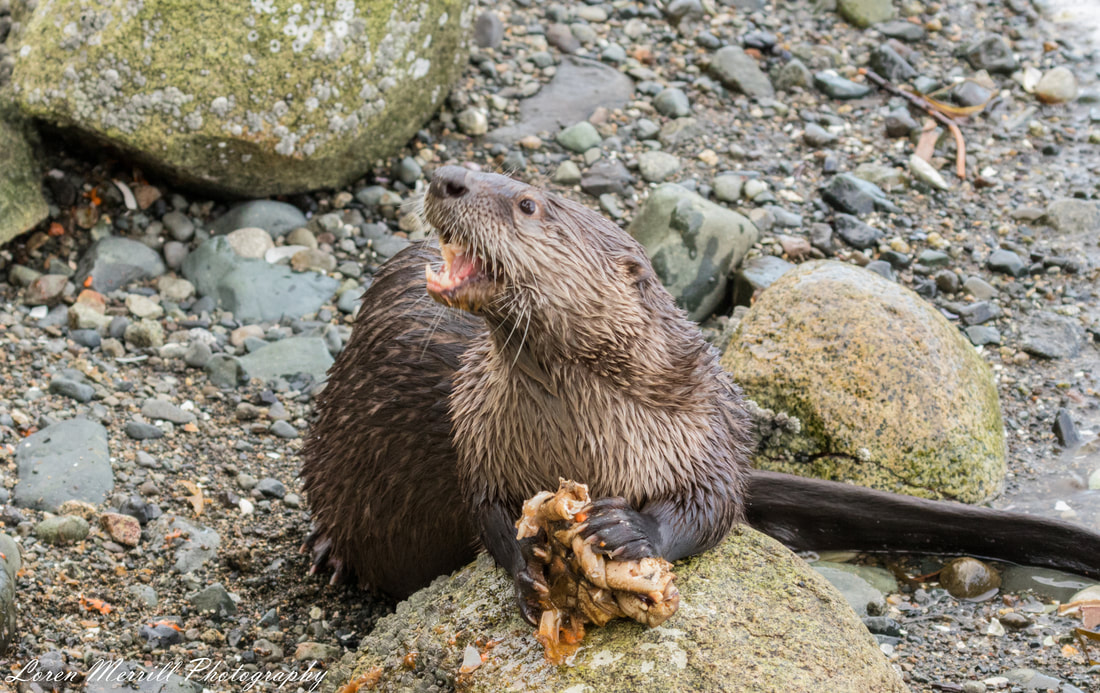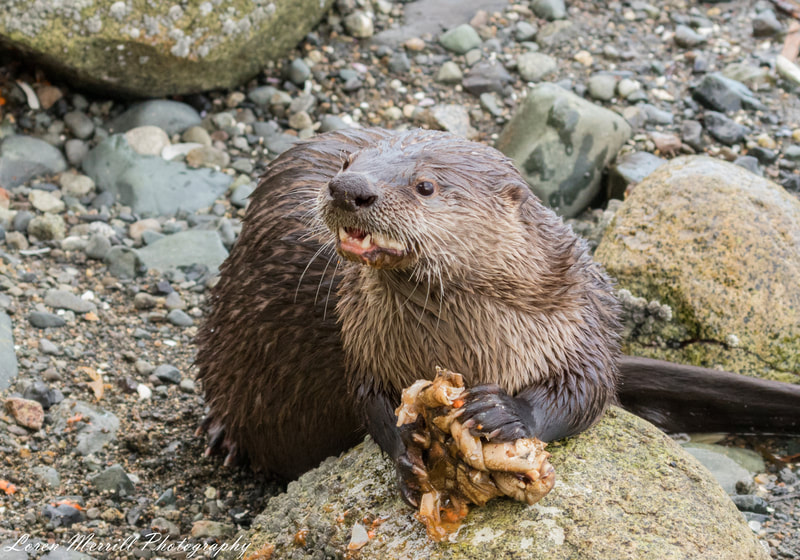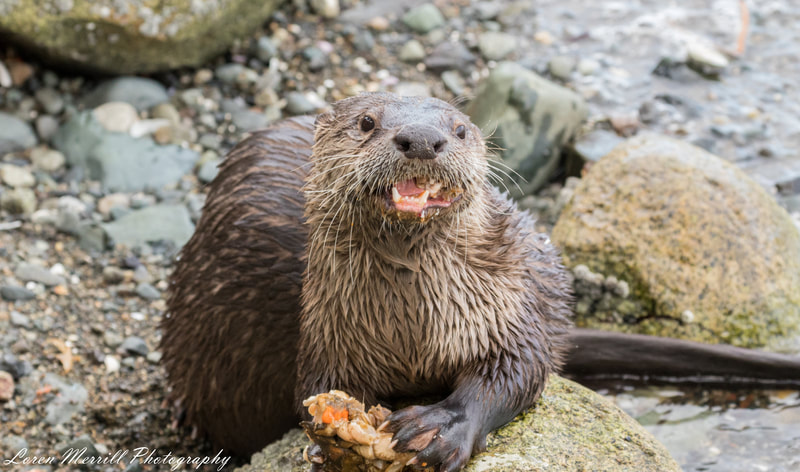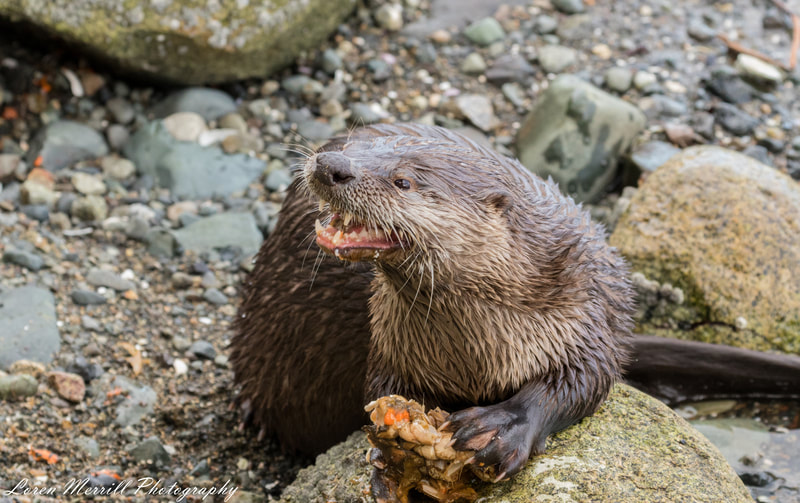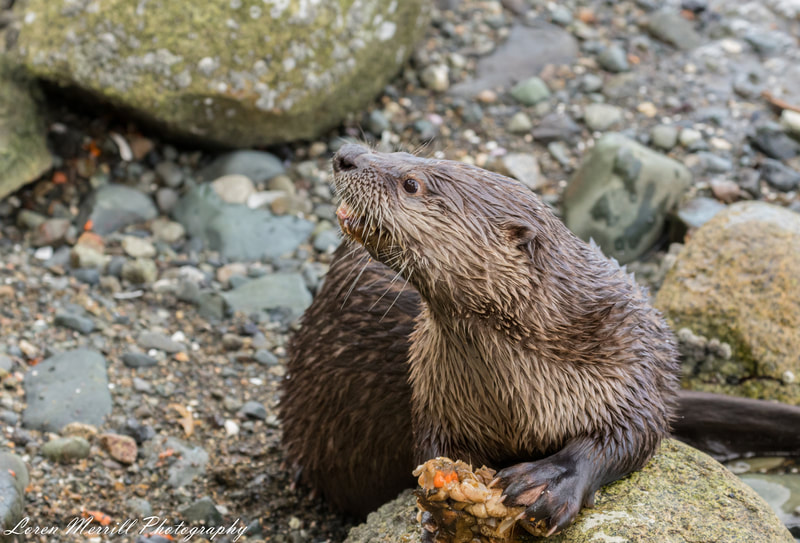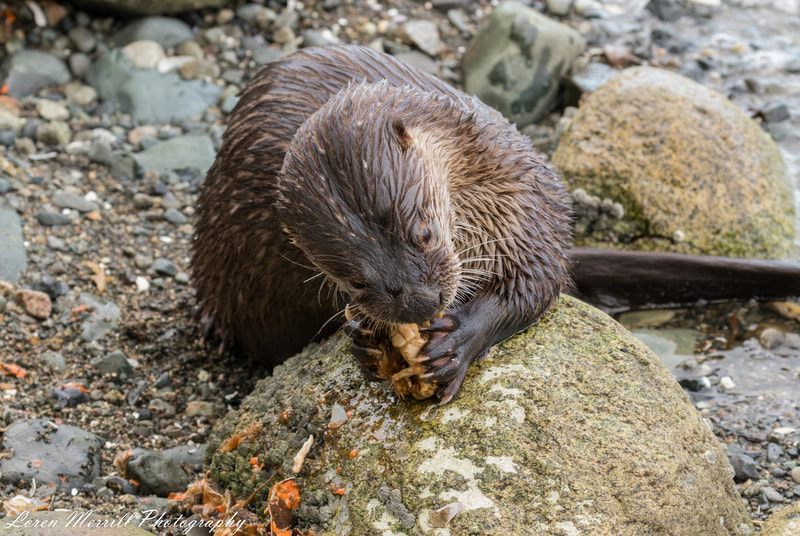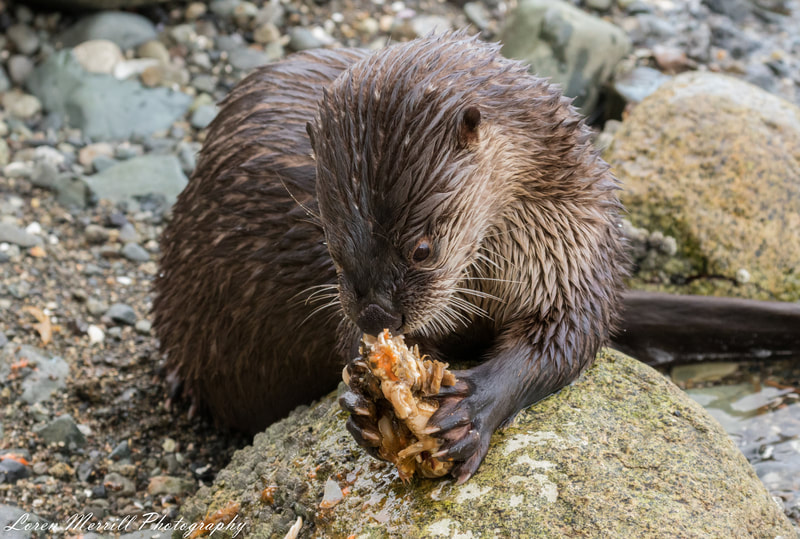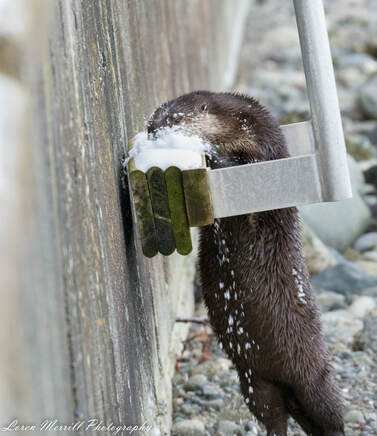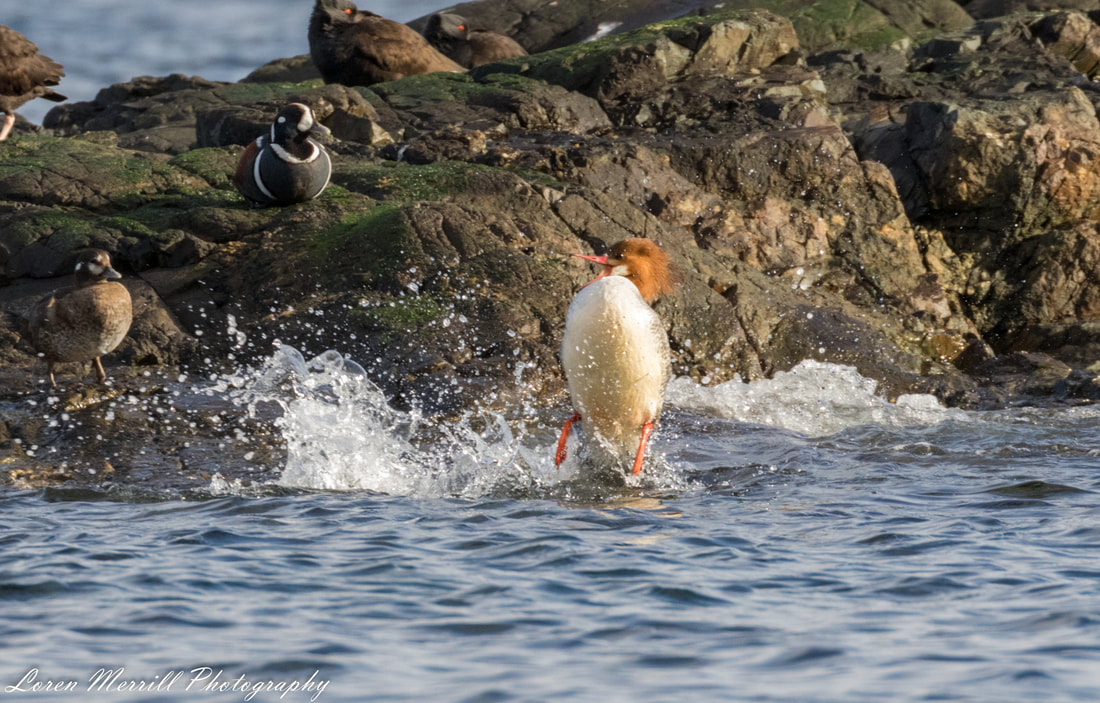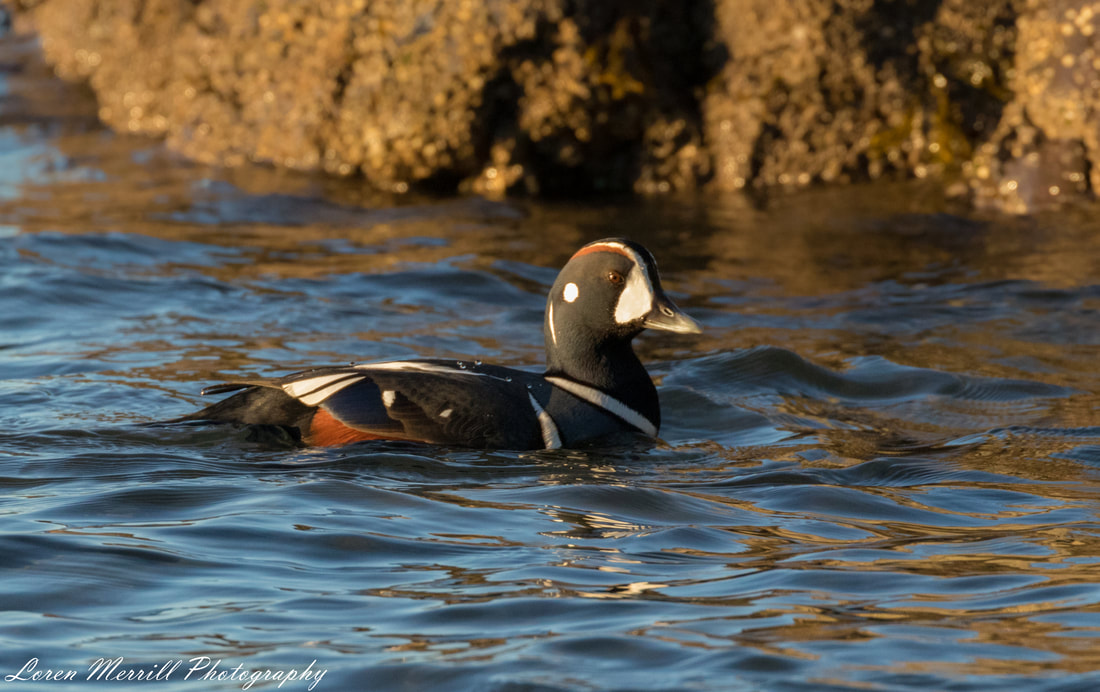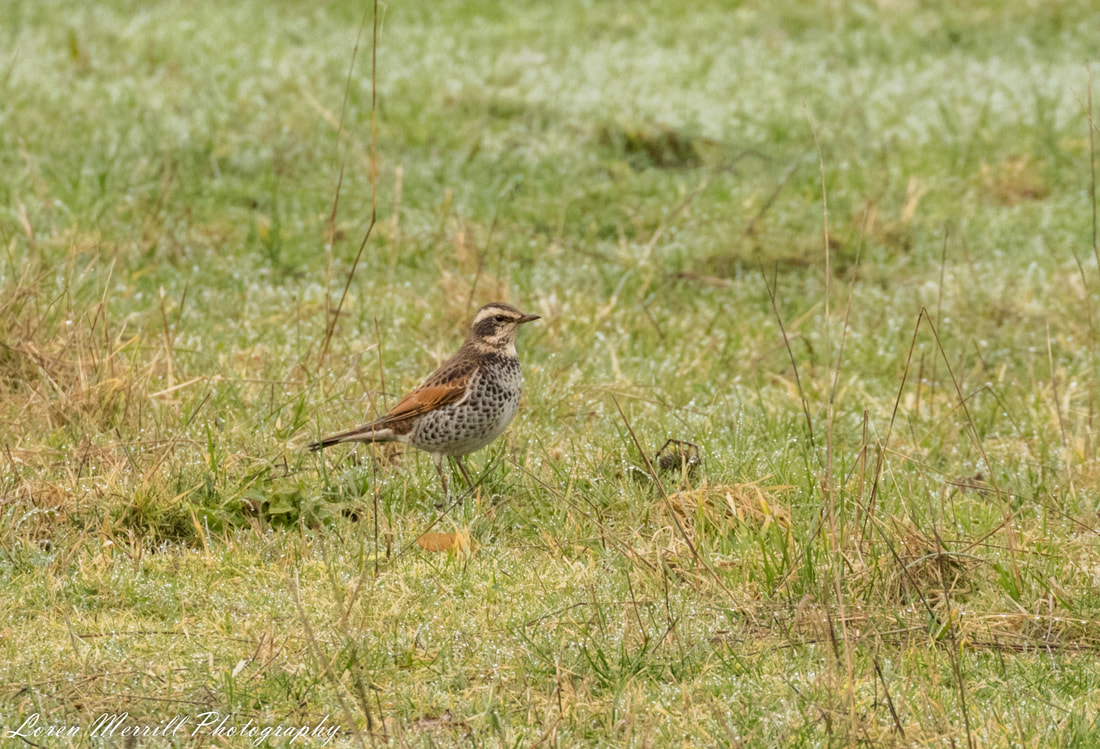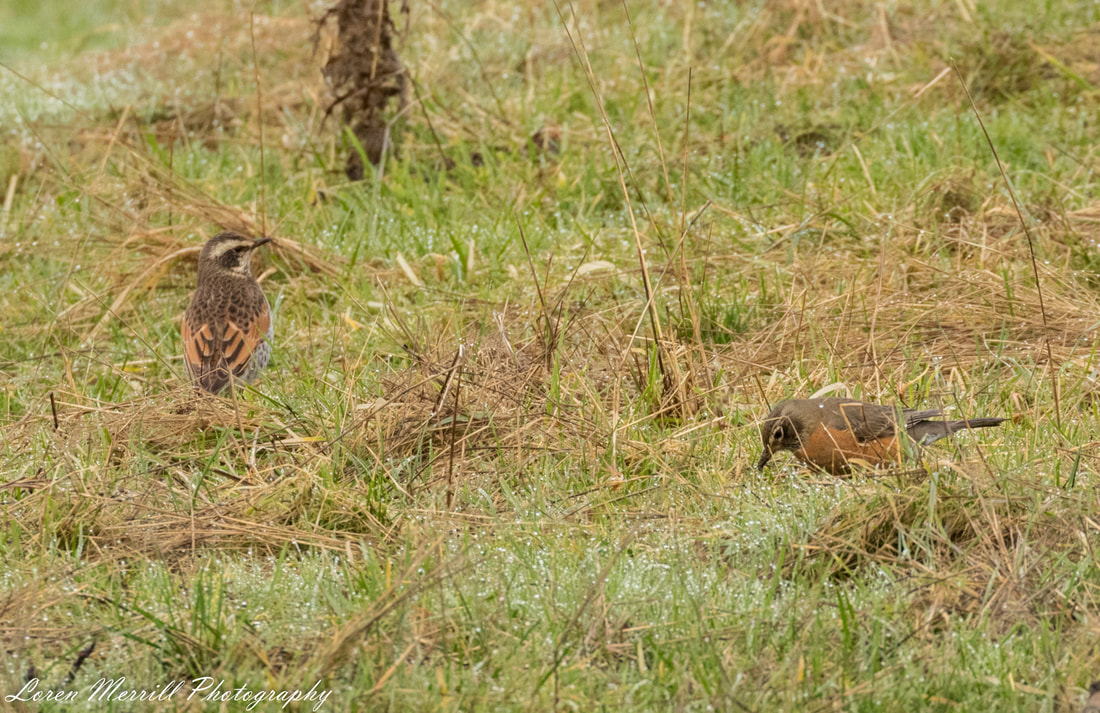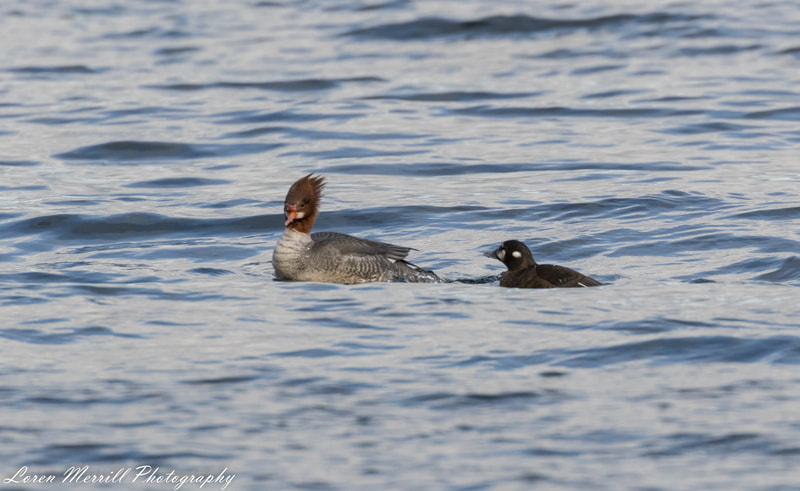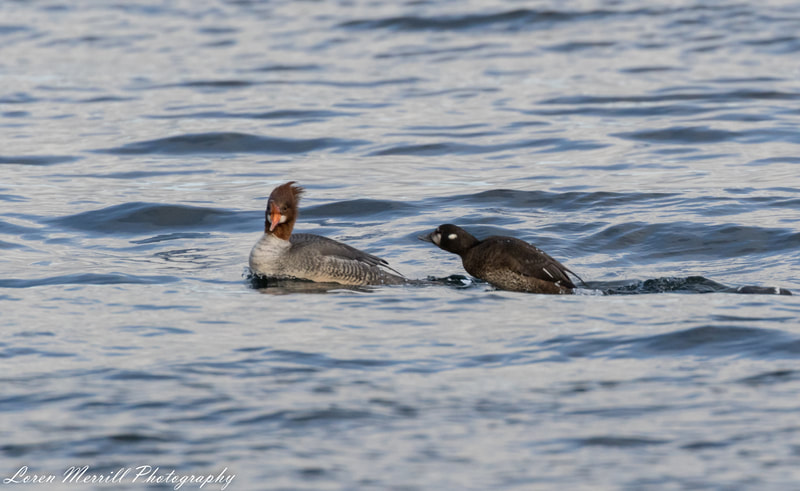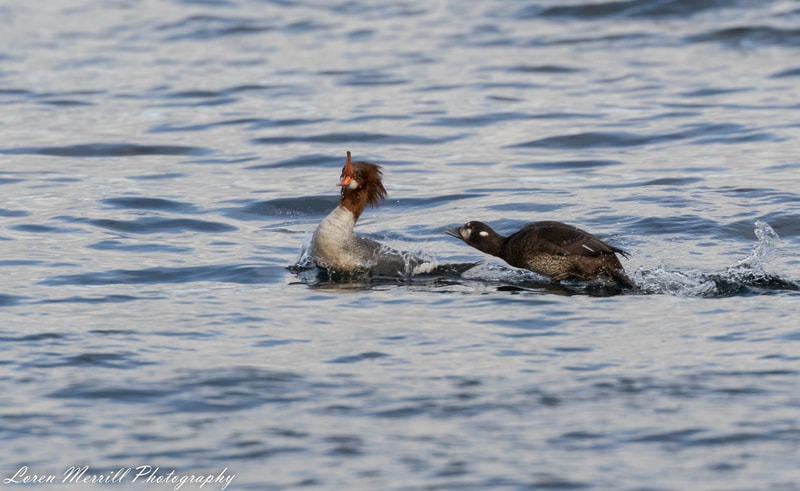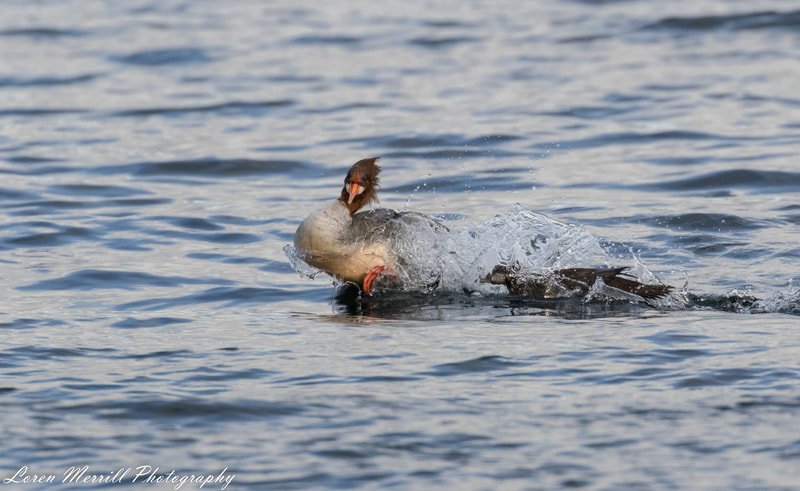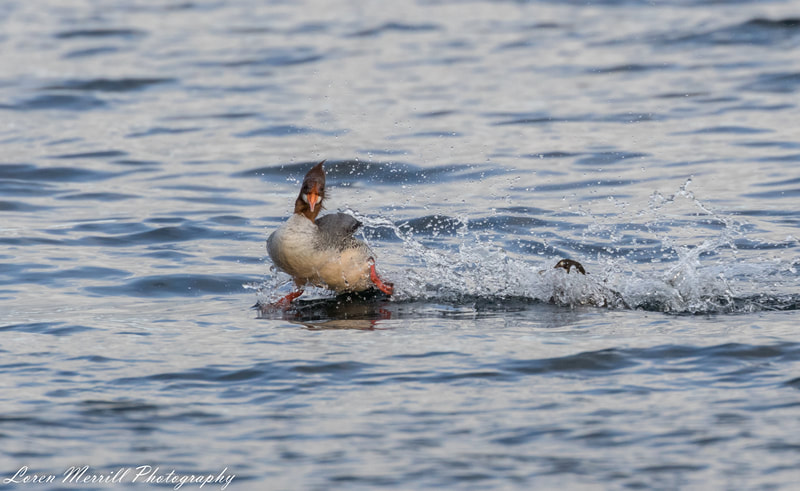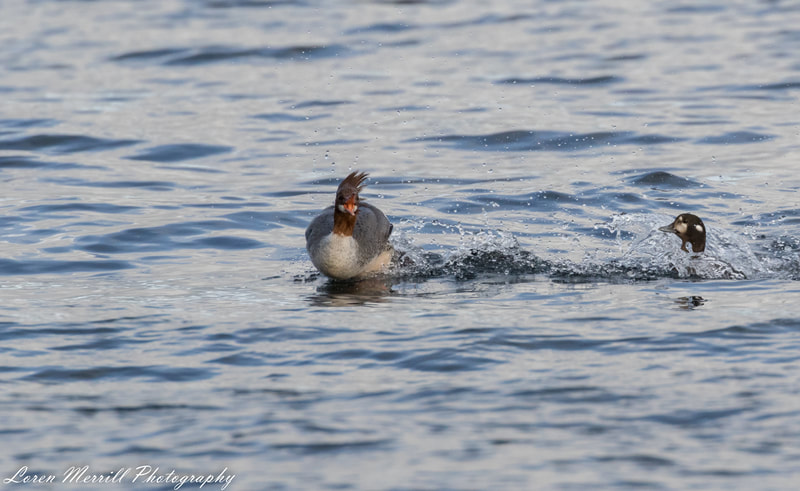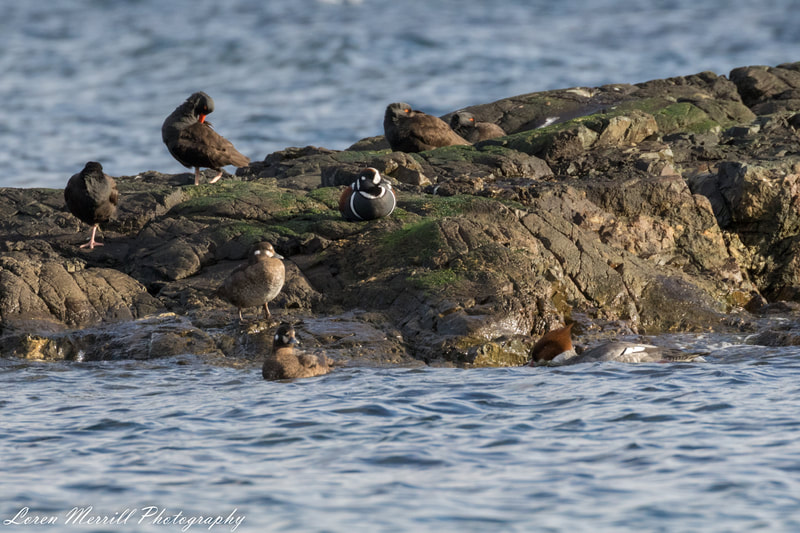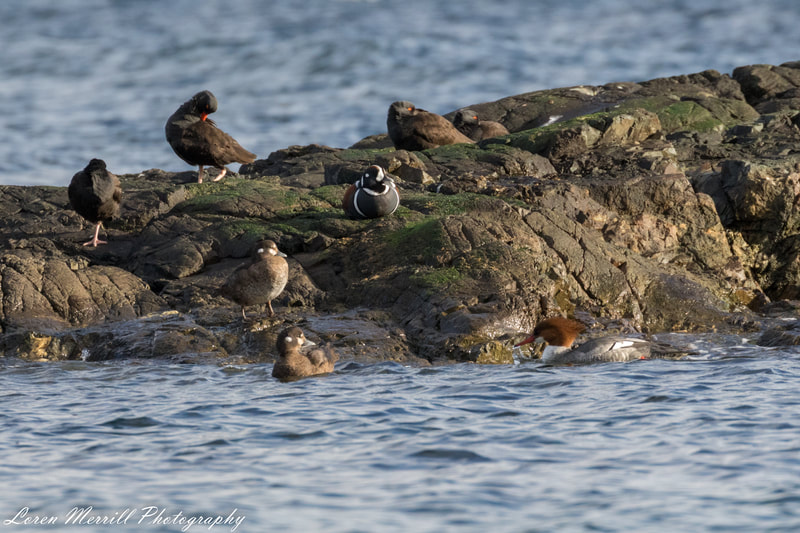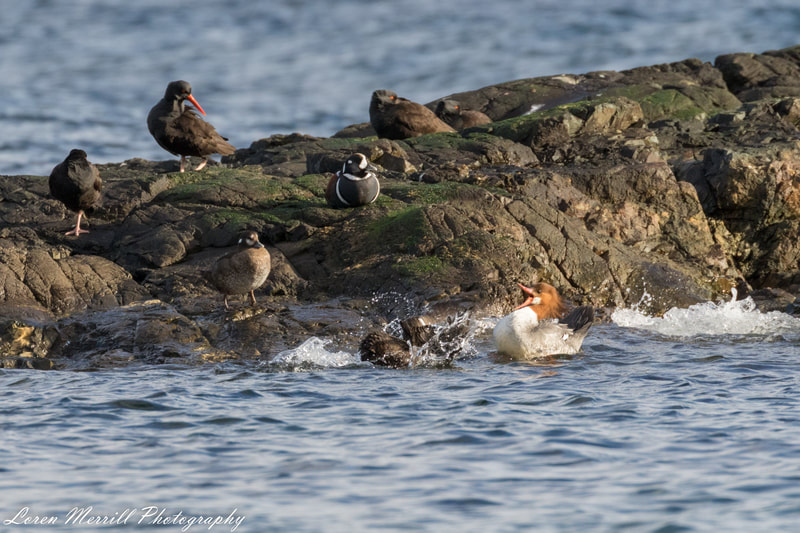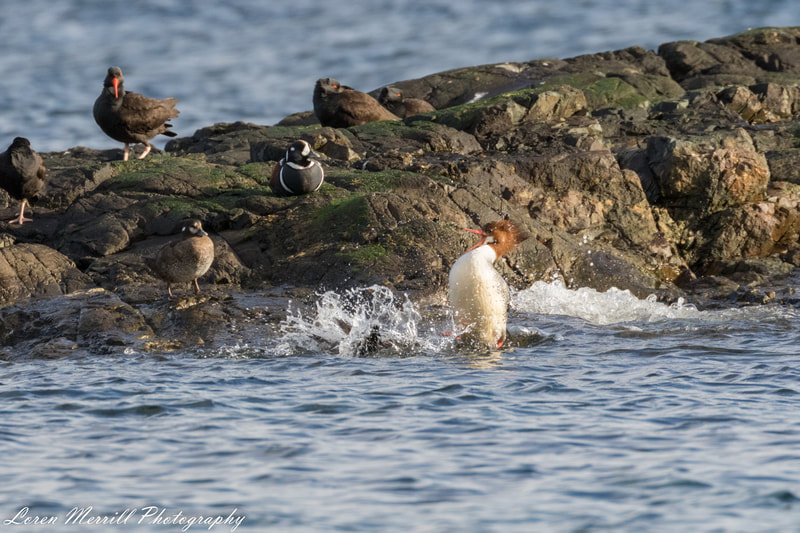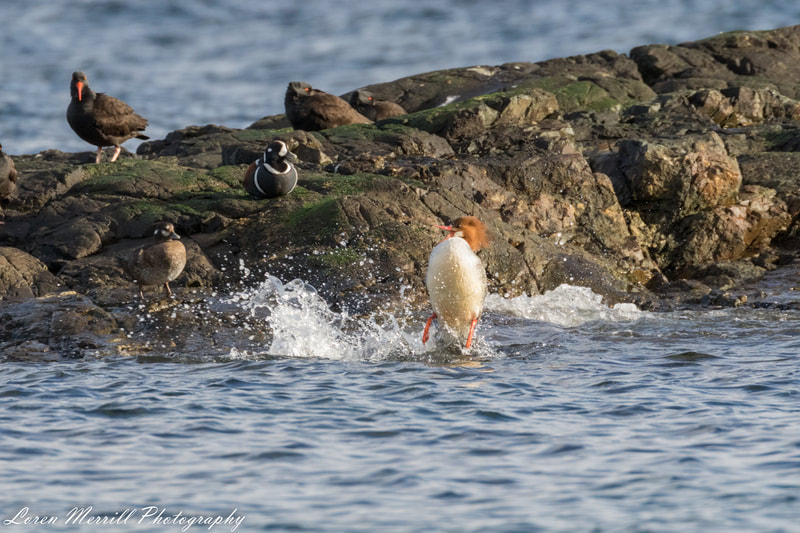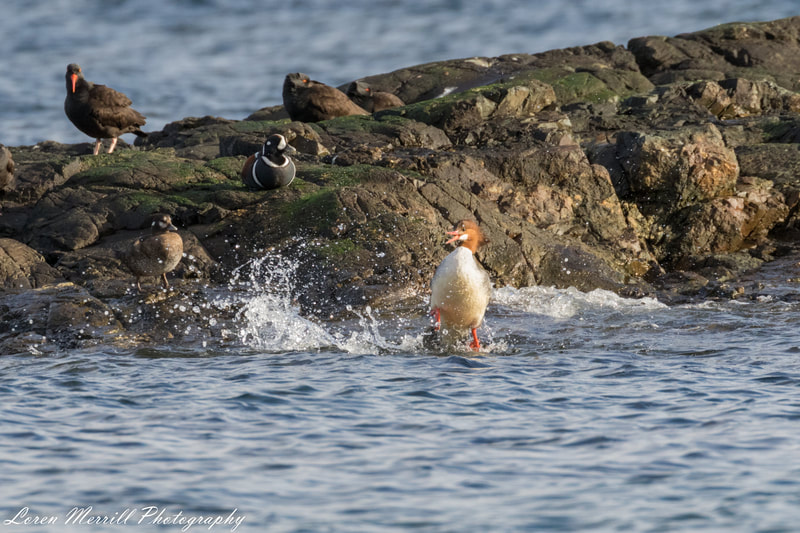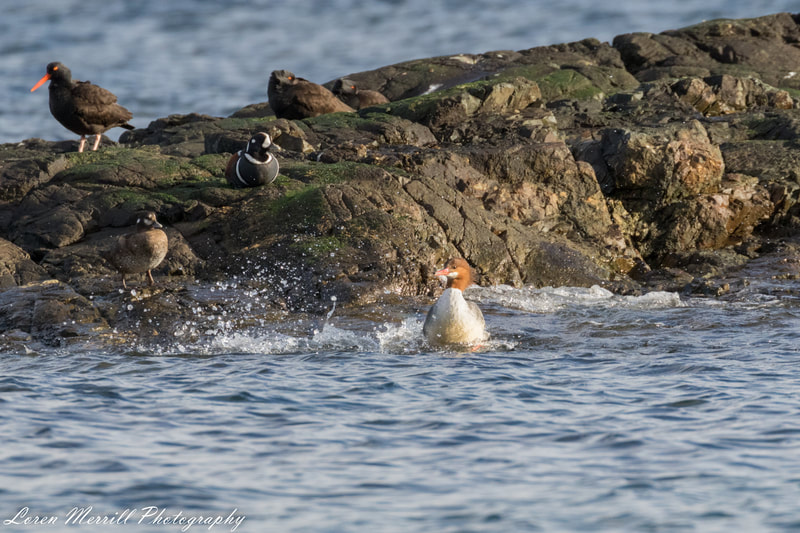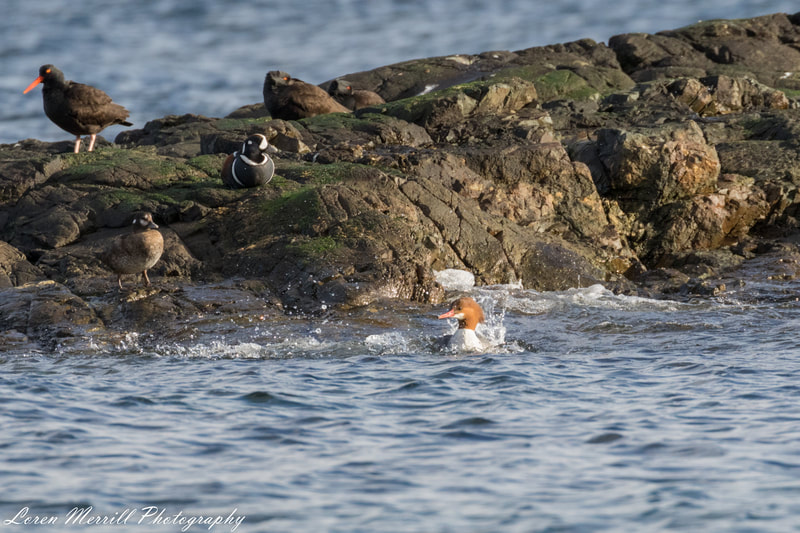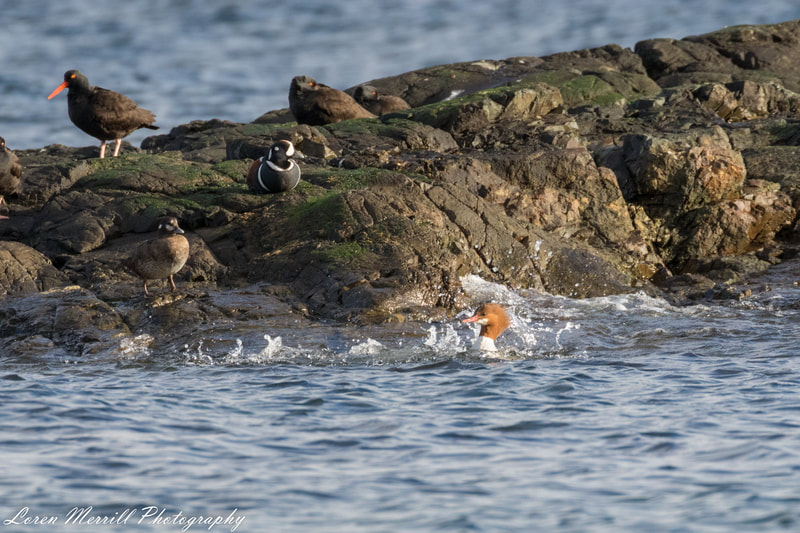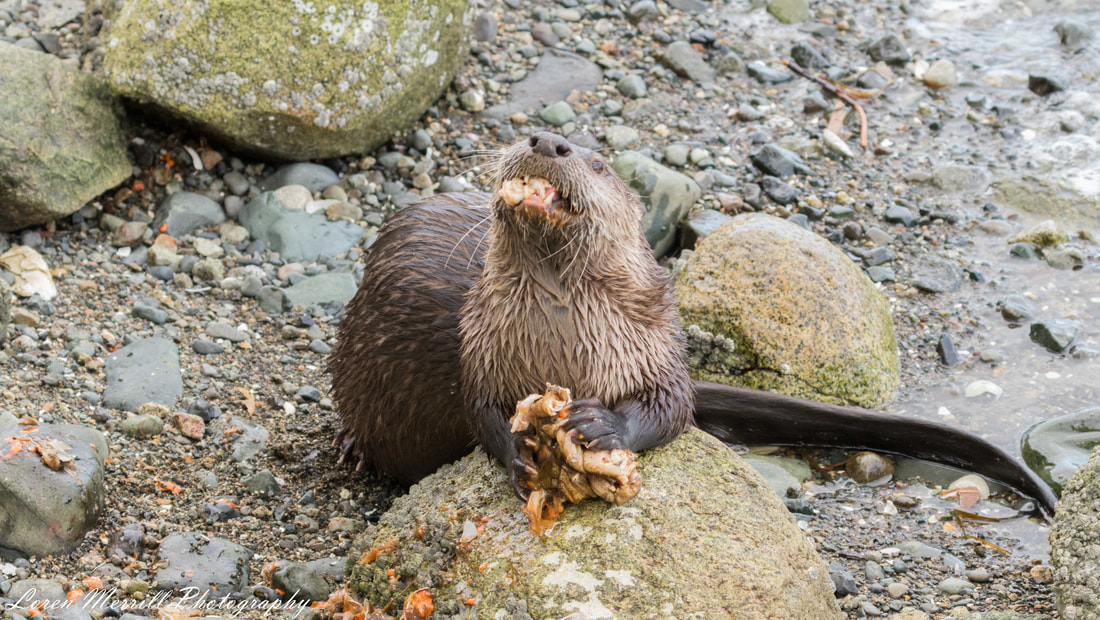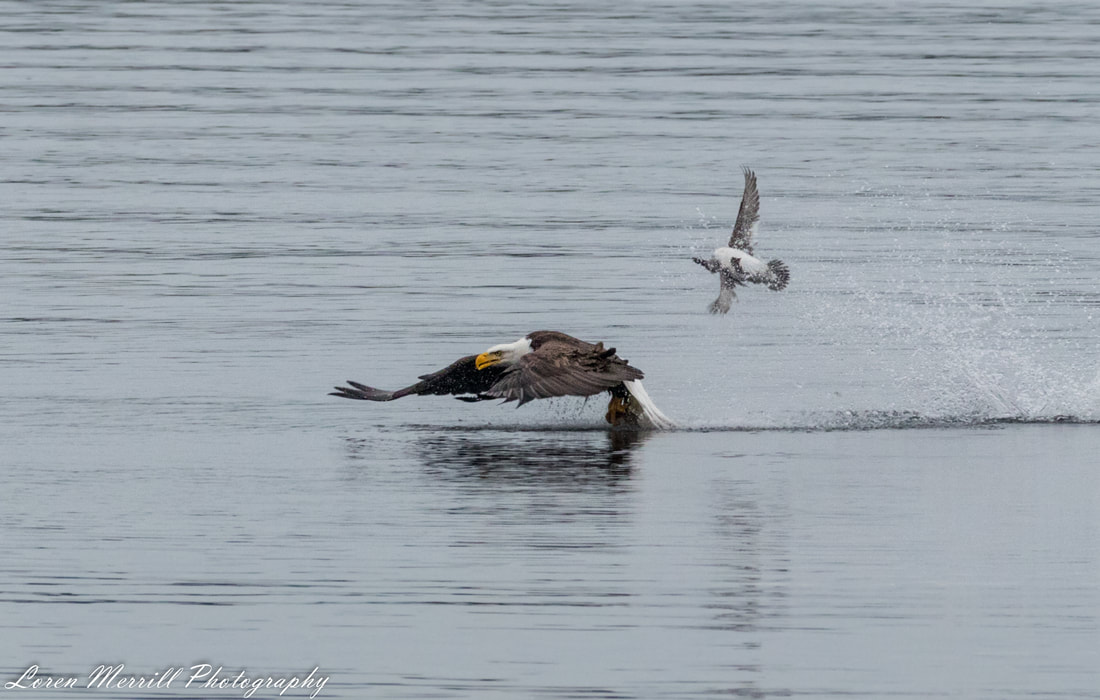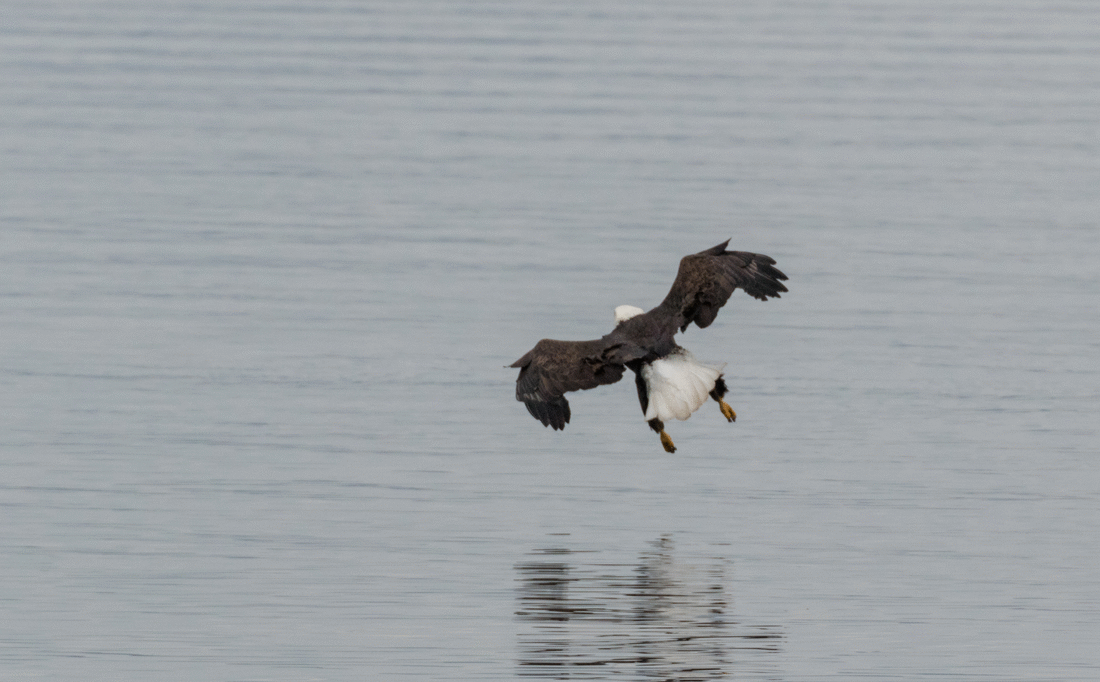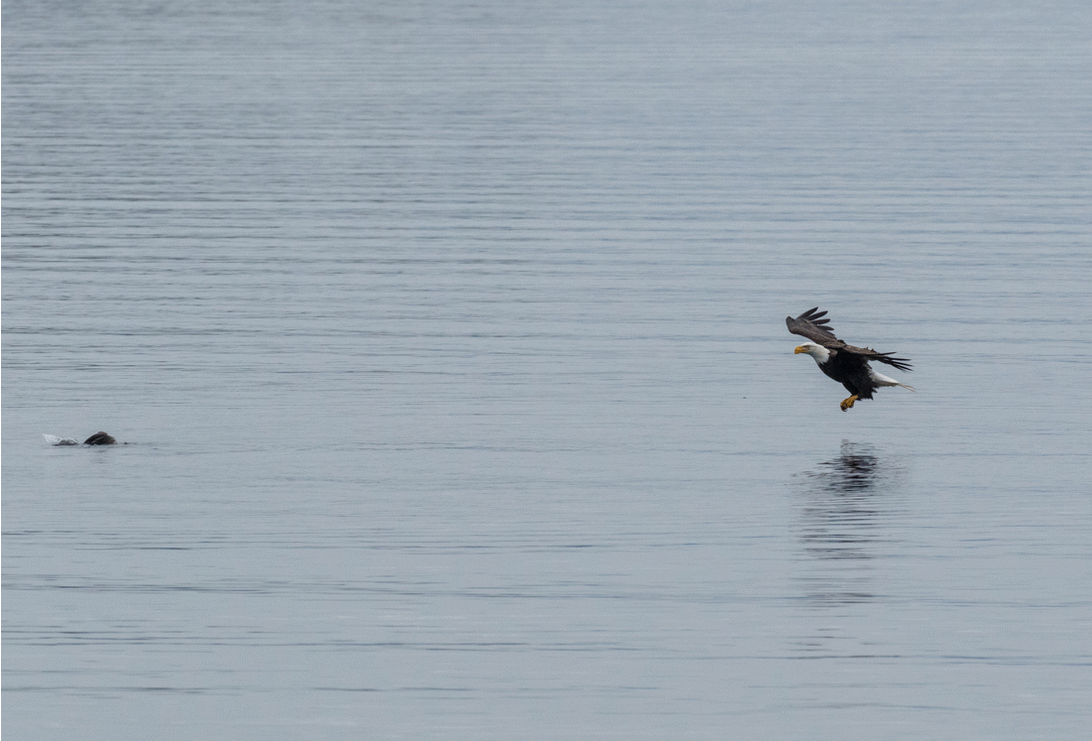|
About a week and a half ago, we witnessed one of the greatest snowfalls in modern Ladysmith history. In less than 72 hours, we received over 20 inches of snow, and some places probably got closer to 26 inches. This region of coastal Vancouver Island generally sees a few minor snow events each winter, in which the snow melts off within a day or two. The last time Ladysmith saw snowfall close to this was in 1996. Our snow was accompanied by a prolonged period of cold, with temperatures dropping into the teens some nights. And the result was a beautiful, wintry landscape: ferns entombed in ice, cedars drooping under the weight of snow, and icicles shimmering along the waterfalls that mark the streams. When we planned our trip to Ladysmith, we envisioned a temperate climate far removed from the icy winters of the Midwest. And for the first few weeks on the island, that’s what we got; balmy 40s during the day, and around freezing at night. It all changed, however, when an arctic air mass parked itself over the island (along with much of the rest of the west coast), and proceeded to funnel cold air over us. Luckily we brought the full complement of winter gear with us, and were able to continue our daily hiking routine. Trudging through knee deep snow, however, gets to be a tad exhausting. Our trials with the weather seemed minor compared with the challenges facing the local flora and fauna. Trees lost their branches (and sometimes toppled over themselves) as the snow piled higher on their boughs. Ferns and recently emerged bulbs disappeared under the accumulating snowpack. We watched as Pacific wrens and song sparrows turned into troglodytes, disappearing into snowcaves in search of insects and seeds, and wondered how much of the local wildlife would succumb to the weather. 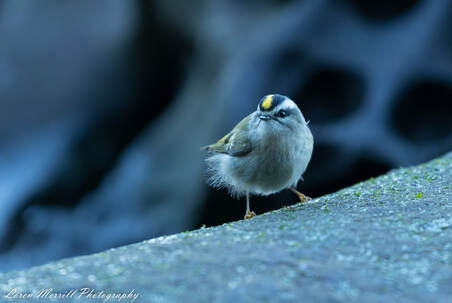 Golden-crowned kinglet foraging on frozen algae. Roberts Memorial Provincial Park, Ladysmith, BC. Golden-crowned kinglet foraging on frozen algae. Roberts Memorial Provincial Park, Ladysmith, BC. But most organisms are generally equipped to deal with unusual or variable weather (to a degree). For some species, that means doing your food shopping in new places. Two weekends ago I visited the Roberts Memorial Provincial Park, which is only about 25 minutes away from us. After a short trek through the forest, I arrived at the rock-ledge coastline. From the ledge I could just see a flock of American wigeon bouncing in the waves a little offshore. Closer by a Pacific wren popped up from behind a large log stranded on the rocks. The wren hopped its way along the log, and then disappeared into the granite cracks. I walked along the ledge a little ways until my attention was drawn to some scrubby vegetation at the interface of rock and forest. A small group of golden-crowned kinglets emerged from the firs and cedars, and buzzed past me to land on the rock ledge near the gently lapping waves. Seeing these fluffy golf-ball-shaped birds in the intertidal was a first for me, so I stopped to watch them interact with this new habitat. The group of 3 birds hopped around, stooping every so often to peck at the rock. I followed one closely with my camera, trying to determine what it was extracting from the almost barren surface. It seemed they were pecking off bits of partially frozen algae or lichen. Kinglets usually eat insects and other small arthropods, although they will eat small seeds if necessary. The temperatures of the preceding few nights had been abnormally cold for the area, and I can only speculate that the kinglets at that park had learned that they could extract some nutrients or energy from the living bits on the rocks. (It’s also possible that this is normal behavior for those particular birds, and I just happened to be there to record it during a cold stretch.) The kinglets were not the only unusual visitors to the intertidal zone. Between Tuesday and Wednesday last week, I observed three thrush species foraging below the high tide mark at our place: an America robin, two varied thrushes, and a lone hermit thrush. American robins are habitat generalists, so their presence wasn’t entirely surprising. But the other thrushes, especially the varied thrush, are typically denizens of the deep conifer forests, and their appearance on the coast coincided with the blanket of snow we received. It is possible, perhaps likely, that these three birds descended from their forested hillside because their normal food resources were covered under 2 feet of snow, and the intertidal was snow-free. I noticed the robin on Tuesday during the afternoon snow. At first I didn’t think too much of it because I’ve occasionally seen robins along our seawall. This bird was foraging around the mouth of the nearby stream (the “otter stream” as I like to think of it), and walking on rocks exposed by the retreating tide. I was hiding behind some large rocks nearby, trying to photograph an otter eating (surprise) another crab. The robin was so striking that I averted my attention from the otter for a few minutes and captured the bird as it stood among the falling snowflakes. The next morning I noticed a pair of varied thrushes as they hopped around a narrow patch of exposed shoreline. The birds foraged for an extended period, passing back and forth along the beach, venturing further down as the tide ebbed. The pair was collecting small seeds that had been deposited on the beach by the receding water. I am not particularly well acquainted with varied thrushes, so I don’t know how much behavioral and habitat flexibility they exhibit, but to me they embody the spirit of the Pacific Northwest’s rainforests. Seeing them forage below the high tide mark along a developed patch of coastline in Ladysmith felt so incongruous with where I normally encounter them, and really accentuated how odd the snow event was. 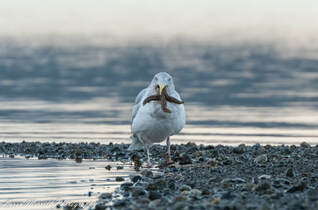 Glaucus-winged gull trying to swallow a very large sea star. Ladysmith, BC. Glaucus-winged gull trying to swallow a very large sea star. Ladysmith, BC. That evening, as the sun made its descent, the hermit thrush appeared. It was low tide and I was out on the exposed flats photographing a gull trying to swallow a giant sea-star. Out of the corner of my eye I noticed a small brown bird hopping around not too far away. Realizing it was a hermit thrush, I watched as this third forest bird bounced around the beach looking for exposed invertebrates. It navigated around the exposed oysters, clams, and barnacle-covered rocks, and even hopped right past my rubber-booted feet. I was never able to tell what the hermit thrush was eating (if anything) but it tended to stay close to a small rivulet of fresh water, and would occasionally peck at things at the water’s edge. I watched until the light waned, and then headed back across the crunchy flats. The three thrushes remained in the area until the following morning, but I have not seen them since. The final bird-in-snow vignette I will leave you with concerns our local great blue heron. This bird (I am pretty sure it’s the same bird) has a few preferred hunting and resting spots in the immediate vicinity, and one of those spots is near the mouth of “otter stream,” just to our east. Early last Wednesday morning, following an overnight snowfall of about 6 inches, the heron was perched on some rocks near the stream mouth. The incoming tide was lapping at the heron’s feet, and I thought a long exposure shot of the heron and the water might be interesting. Long exposure shots generally don’t work well with living animals (if they move at all during the exposure, they just become blurry blobs), but herons are adept at remaining motionless for long periods of time, so I figured it was worth a shot. I set up the camera and played around with different settings, eventually settling on a 2 second exposure as a compromise between the longer period I wanted and the duration of time the heron agreed to remain motionless. I left the hunched heron after the photoshoot, and went inside to work. A little while later I looked out and saw the heron had been pushed off its rock by the rising tide, and had flown to the top of the nearby seawall. As I watched, the heron decided to traverse the wall.
Now, at this time, the seawall was covered in about 15 inches of snow and the heron was attempting to walk on top of the snow. Herons have long, extended toes that work reasonably well for distributing their weight out across a relatively broad area. But deep snow is not something herons are used to dealing with. Tara and I watched with guilty pleasure as this poor bird tried to walk on top of the snow, and failed. It was the perfect reenactment of every time I’ve walked on slightly crusted over snow; the heron would gingerly step forward, placing its foot into the snow, which would generally yield a few inches and then hold. The heron would then lift its other foot, at which point the supporting foot would suddenly punch down 6-12 inches into the snow, forcing the heron to open its wings to steady itself against toppling over. Once steadied, the bird would try the maneuver again with the other foot. We watched the bird slowly traverse the wall- step, lift, sink, flap, repeat-- until after going about 5 feet it decided that was enough, and it settled down for a well-deserved rest. The snow is now mostly gone along the coast. Some places in the woods still have 6 inches or more in heavily shaded areas, but the snowpack that I was convinced would be here until we leave is dwindling rapidly. Temperatures have moderated, and most of the birds have resumed their normal activities. There is still snow in the forecast over the next week or two, but it feels as though we’ve turned a corner. The days are getting longer, and the sun has made a noticeable shift to the north when it emerges over the horizon. We have only one more week here in Ladysmith before we move to Quadra Island, located a few hours north. I am equal parts excited about the next leg of our adventure, and sad about leaving our wonderful home by the sea and all the friends we’ve made here, human and non-human alike. But anything can happen in a week—just ask the varied thrush. Next time: Log-dump! The Log Boats of Ladysmith Habo(u)r and Adventures with Dippers
0 Comments
One month in our Ladysmith home has revealed a few of the natural rhythms of the area. The tides exhibit remarkable variation, even over the course of a day. The water may recede a hundred meters from the seawall in the early morning, and barely reach 10 meters in the evening. Each day’s variation changes over the course of the week and month and is tied to the lunar cycle, as well as the earth’s position around the sun. While we don’t see too much of the sun, when it does emerge, it so dramatically changes the landscape you feel as though you have been transported to an entirely new location. In its absence, the area is cloaked in low clouds with wispy strands of fog clinging to the trees. When the sun shines, the soft, beveled edges to the world vanish, and everything is brought into sharp focus. Ladysmith possesses an ever-changing landscape that we feel very fortunate to be a part of. One of the constants here is the crow commute. Northwestern crows are abundant in the area, and they roost off to our west. Every morning before sunrise, the crows stream out from their nighttime sanctuary, flying over the harbor and cawing away at one another as they make their plans for the day. In the evening, they make the return journey, sometimes in one large, cloudlike flock, expanding and condensing as they travel. During the day, smaller flocks or individual birds can be seen flying overhead or bouncing around the coastline. Crows are supreme generalists, and will take advantage of just about any food source. Here on the coast, that includes leftover seafood from another constant in our seaside community: the river otters. Early in our stay, I estimated there to be about 3-4 otters near our home. This initial appraisal proved to be an underestimate, as I saw 6 of them together at one point last week. I’ve seen the otters swim, play in the snow, and chase ducks, but by far the most common activity they engage in is eating. Otters are opportunistic foragers and will generally target the most accessible food source available. In Ladysmith Harbor, that is undoubtedly crab. Last week, I watched as three otters huddled together on the rocks near the stream mouth, and crunched their way through a large Dungeness crab. Not long thereafter, one of the otters broke away from the group and started heading my way. I tried to estimate where its trajectory would take it, and positioned myself at the edge of our seawall, crouching low so as to not spook the otter if it approached. Sure enough, the small otter (presumably an individual from last year’s litter) appeared around the corner of our seawall, and proceeded to crawl from the water onto the small rocky beach below me. I was perched only 10 feet away and began capturing the action on my camera. 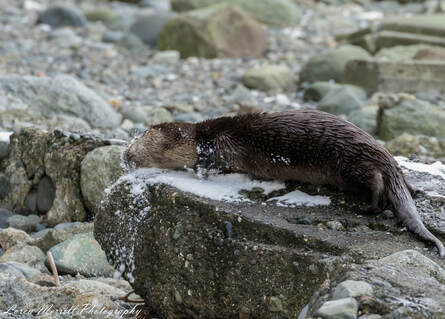 A river otter rolls its face and upper body around in a small patch of snow. Ladysmith, BC. A river otter rolls its face and upper body around in a small patch of snow. Ladysmith, BC. At first, the otter casually explored the rocky beach. With no particular intention, it nosed its way around the rocks, and wandered into and out of the water. But after a short bit of this meandering, the otter snuffled its way to the remains of a large crab and got to business. I’ve watched the otters here eat crab in all sorts of positions. They eat while they swim, employing an exaggerated open-mouthed chewing style. They eat standing on all fours along the shoreline like a cat or a dog might. They even eat lying on their bellies, pinning their crab to the ground while they munch away. But this little fellow propped its forelimbs and upper body up onto a large table of a rock, grabbed the crab with its front paws, and dined on the crab in style. For ten minutes the otter consumed the crab with gusto, crunching through the tough shell, and extracting the rich meat inside. Maybe the otter was unaware of my presence, or maybe it was simply too overcome with seafood joy to care, but the small otter never once appeared to be concerned that I was so close. After devouring the crab, and sniffing around to clean up the scattered bits and pieces, the otter headed away from me and down the beach. It found a few pockets of fresh water where it paused to quench its thirst, and then went about cleaning up from its meal. At first the otter rubbed its muzzle on a barnacled rock, trying to scratch off the crab residue. Then the otter discovered a patch of snow, and that’s when the cleansing really commenced. First the otter crawled onto the patch of snow, and began gently rolling its face in the white flakes. Apparently pleased with the face bath, the otter then began rolling its upper body in the snow. Now this particular swath of snow wasn’t that large, and it wasn’t long before the otter went off in search of a larger patch. The otter located another small snow mound on the lower rungs of a ladder at our neighbor’s home, and stood up on its hind limbs to gain access. The otter shoveled its snout through the mound, pushing much of the now off the ladder and onto the beach, and after a few moments of this, headed off again in search of a more substantial yield.
The otter wandered further down the beach, and disappeared into another neighbor’s snow-covered yard. And the last I saw of the otter that morning was as it performed a full-body slide through the snow and disappeared into the bushes. Next post: The Storm of Storms 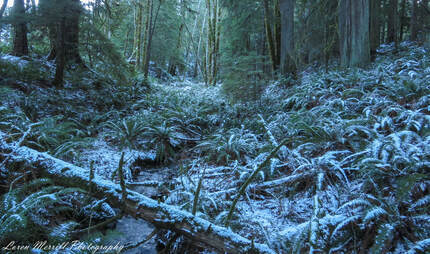 After one of the earlier snowfalls, I went to the Holland Creek Trail to enjoy the scenery. Ladysmith, BC. After one of the earlier snowfalls, I went to the Holland Creek Trail to enjoy the scenery. Ladysmith, BC. I know. Back to back posts with duck in the title? Don’t worry—it will all be worth it. Our time on the island has been marked by remarkably stable weather. Highs during the day in the mid-40s (that’s Fahrenheit of course) and in the low 30s at night. Quite temperate given that we live at the 49th parallel. That stability took a plunge early this week, and we are currently experiencing an extended cold-snap. What’s more, those cold temps have been accompanied by frozen precipitation; an inch of snow here, a half inch there, maybe 3-4 inches today. The result is a frosted green and white landscape of ferns and conifers cloaked in snow, and patches of moss donning little snow fedoras. Apparently such a prolonged period of cold and snow is an unusual event around here, and it will be interesting to see how the flora and fauna respond. The point of all this is to say that the generally mild and stable climate during the winter makes the island a top wintering destination for a multitude of migrating waterfowl. You’ve already met the buffleheads and goldeneyes, but there are many species of duck, loon, and grebe that come here for the cold months to bask in the light drizzle that embodies the Pacific Northwest’s winter. One of my favorite ducks is the harlequin duck, which made a brief cameo in Post 2 at Washington Park, Anacortes. The males of this species are quite striking- a blue/gray base accented with bold black and white markings, and a large chestnut patch on the sides. If you are ever lucky enough be close to these birds when they vocalize, you might be a tad taken aback by the noise that comes out of their beak. It’s a rather odd squeaking sound, which has led to the creation of a wonderful nickname: the sea mouse. This aquatic rodent-duck breeds along fast-flowing streams of the far north, and mountainous areas of the Pacific Northwest, Idaho, Montana and Wyoming. During the winter, it prefers rocky coastal waters with good wave action where it dives for fish and aquatic invertebrates such as crabs and bivalves. As ducks go, the harlequin duck is on the small side, but I learned recently that they have some big attitude to go with their diminutive stature. A few weeks back, Tara and I ventured north to Nanaimo to go check out a dusky thrush that my friend Philina had texted me about. This bird breeds in Siberia and typically winters in India, Vietnam, China, and adjacent countries in Asia. So its appearance on Vancouver Island was unexpected. As in “third record in British Columbia ever” unexpected. Tara and I navigated to the area the bird had been reported, and a flock of birders standing around with binoculars and spotting scopes was the cue that we were in the right spot. When we sidled up to the group, the bird was not in view, but within 15 minutes someone had re-spotted it a little ways down a side road. The crazy vagrant bird was initially perched high up in a cedar, partially hidden from view, but after a little while it flew to the ground where it began foraging along with a mixed flock of juncos, yellow-rumped warblers, golden-crowned and song sparrows, and American robins. The dusky thrush was very similar in shape, size, and behavior to the robins, and their proximity to one another allowed for an easy comparison. We watched the bird for half an hour, said goodbye to the Siberian visitor and our new birding friends, and made our way to Neck Point State Park for some coastal birding. 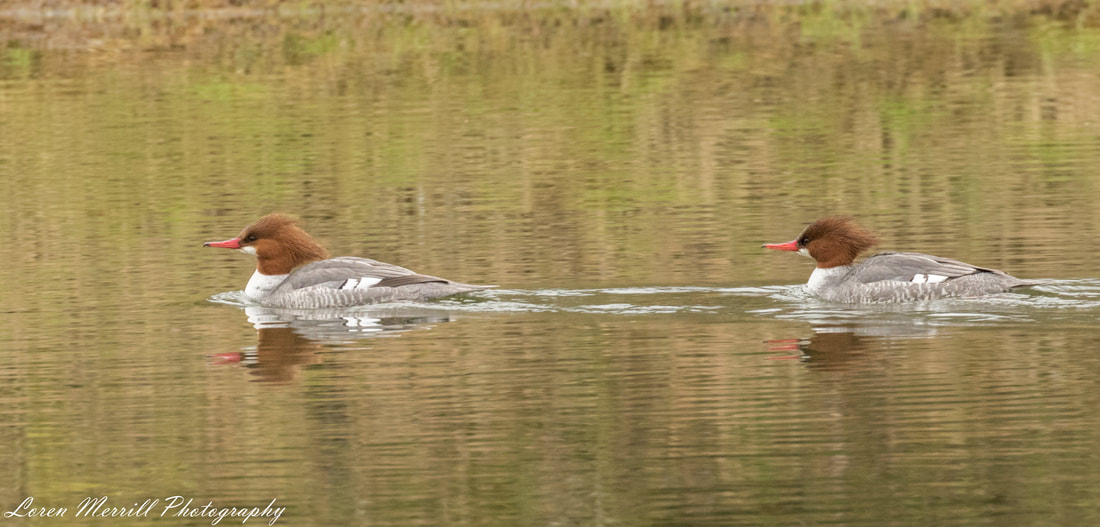 A pair of female Common Mergansers in the coastal waters of Vancouver Island, BC. A pair of female Common Mergansers in the coastal waters of Vancouver Island, BC. By the time we arrived at the park, the sun had shed its gray cloak and was shining brilliantly. An easterly breeze had arisen, stirring the water to action, and in the Strait of Georgia, the blue expanse was punctuated with whitecaps. We found a nice path that hugged the rugged coastline and headed off. We didn’t get to too far before we came across some rocky ledges just offshore that were covered in birds. Black oystercatchers, surfbirds, cormorants, and a bunch of harlequin ducks. There were also harlequin ducks in the water, and I began trying to get some good shots of them swimming. There were also a handful of common mergansers plying the shallow waters, and I split my attention between the two species. Common mergansers are ducks like the harlequins, but they have a long, narrow, serrated bill that’s custom-built for catching and holding onto slippery fish, which make up the bulk of their diet. In the winter, however, they’re not opposed to adding some crab to the menu. The merganser’s foraging tactic in shallow water typically consists of the bird swimming slowly on the surface, and occasionally sticking its head partially underwater (just past the eyes) to sneak a peek at the action. If it sees a fish or crab or promising terrain that warrants closer inspection, the bird disappears under the waves. They propel themselves underwater using their webbed feet, and their long, snake-like neck allows them to probe into small nooks and crevices. They usually swallow their food underwater, but occasionally a bird would surface with some small prey item before getting it properly positioned and gulping it down. I was happily snapping pics of the birds and happened to look over a little to my left where a female common merganser was swimming towards a small group of harlequin ducks. I thought it might make an interesting shot to get both species in the frame, and so I shifted my attention to those birds. Almost as soon as I began taking pictures, one of the female harlequin ducks made a beeline for the merganser, and what must have been simmering tensions rapidly boiled over into an all-out attack. Who knows what the personal histories of these two individuals was, but for some reason, that female harlequin duck decided that she did not like that female common merganser and did not want her in the area. Maybe that merganser stole a crab from her earlier in the day. Maybe a different merganser stole a crab from her the year before, and she’s harbored a grudge against all mergansers ever since. We’ll never know. But as the sequence of images shows, the duck has the steely look of death in her eyes as she launches herself at the merganser which appears to have been caught completely by surprise. I love the expression of indignation that the merganser conveys, but I’ll let the images tell the story of the encounter themselves. What I didn’t know at the time was that this was not an isolated episode, and that the Napoleonic harlequin duck wasn’t done with her vendetta. With the merganser and harlequin ducks no longer in the same frame, my attention drifted away to other birds, and I wandered a little ways down the shoreline. I was brought back to the rocky ledges 20 or 30 minutes later following a bald eagle that had a fish in its talons. When the eagle disappeared, I turned back to the water and noticed a flock of harlequin ducks on and around one of the ledges, and a lone female common merganser making her way towards them. I got the camera up and started shooting. There’s a moment at the beginning of the succeeding episode (2nd image) where the duck and the merganser make eye contact and Tara is convinced the merganser is taunting the harlequin there. Whether that is the case or not, the harlequin is immediately spurred to action. This time, she opts for a submarine attack, and the ensuing sequence is almost a caricature of how one might envision a merganser responding to getting bitten on the butt underwater by the little bully. I can’t help but laugh out loud every time I look at the merganser’s open-beak expression of shock and displeasure. Again, I’ll let the sequence speak for itself. 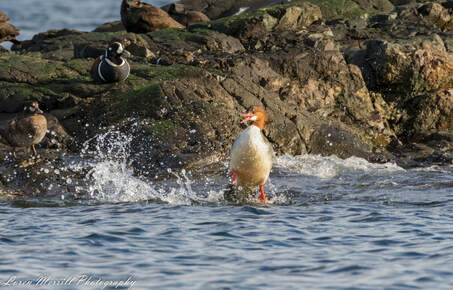 An unlucky female Common Merganser tries to avoid a marauding female Harlequin Duck. Neck Point State Park, BC. An unlucky female Common Merganser tries to avoid a marauding female Harlequin Duck. Neck Point State Park, BC. One of the things I love most about wildlife photography is that it provides a window into behaviors and actions that happen too quickly to perceive in real time. In the above sequences, I never would have seen the merganser’s squawking responses to the harlequin’s attacks, nor would the action of the merganser cartoonishly launching itself out of the water to avoid getting nipped in the butt (or goosed if you will) have been apparent. These insights add extra depth to my encounters and observations, and by capturing it on film, I can continue examining and contemplating the experience long after the encounter is over. In the next post we will return to the otters, and one young individual that consumed a crab just a few feet from me, and then rolled around in the snow to get clean. Or maybe just because it was fun.
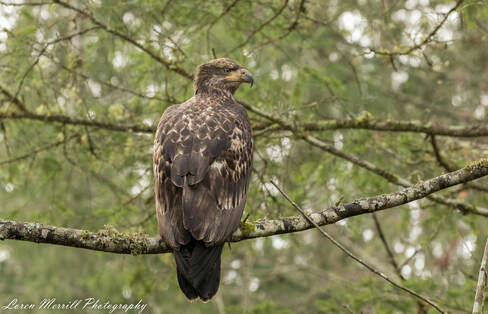 An immature Bald Eagle (likely a first year bird) perches on a branch near Nanaimo, BC. An immature Bald Eagle (likely a first year bird) perches on a branch near Nanaimo, BC. The call of a bald eagle is not well-matched to the predator’s persona; it is a high-pitched, whinnied laugh that seems better suited to a gull or shorebird. So when I heard one calling outside the door last week, I was not immediately roused to investigate. We have lots of eagles in the area, and while I always love watching them, an eagle call does not always warrant further inspection. But in this case, the calling was incessant, and quite loud, so I got up to take a look out the window and quickly realized there was something extraordinary happening. Two adult bald eagles, easily distinguished from immature birds (below) by their pure white heads and tails, were flying around, calling repeatedly. I watched as one bird flew out from the shore with powerful flaps, and began dropping close to the water surface. As it did so, its talons extended downwards, and it made a grab at something in the water (see below). Behind the lens of my camera I attempted to capture the events unfolding out on the water. 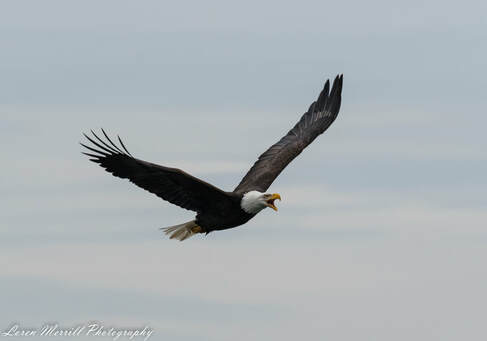 A Bald Eagle flies towards the shore after a failed hunting attempt, expressing its frustration loudly. Ladysmith Harbor, BC. A Bald Eagle flies towards the shore after a failed hunting attempt, expressing its frustration loudly. Ladysmith Harbor, BC. I could not tell what the eagle had swiped at, but the eagle quickly looped around and headed back towards the spot in the water it had struck at moments before, calling loudly as it flew. It made another swipe at the water, and I could see a small, dark shape disappear in the water as the eagle approached. I still had no idea what it was, but thought perhaps it was one of the river otters that had captured a large fish the eagle was trying to steal. After this second attempt, the eagle headed directly towards me, again vocalizing loudly. I tried to see if the bird had anything in its talons, and it appeared as though it did, but I could not be sure. As the bird flew over my head into the trees above our house, I turned back to the water to see the second eagle flying to the same location the first eagle had targeted. Again I could make out some small dark shape that vanished as the eagle swooped low, striking at the water. I took a quick look at the images on the camera and was finally able to get an ID on the target: a female common goldeneye. Common goldeneyes (so named for their bright yellow irises) are diving ducks, and therefore are adept at disappearing beneath the surface of the water. Like the buffleheads highlighted in the previous post, they dive to the bottom of the ocean to search for mollusks and crabs to consume, which they swallow whole, and crush with a powerful gizzard. But this female goldeneye was diving with more at stake than a meal, and was soon going to be facing a pack-like hunting strategy. The second eagle was making passes at the duck, which would attempt to dive before the eagle approached too closely. Eagles make a living finding prey under the surface of the water and timing their attack to grab the prey at, or just below, the surface. I captured a few sequences of the second eagle swooping and striking at the water, but I could not tell in real time what was happening. The lone (second) eagle was joined by another (third) adult eagle, and soon a fourth came out, and these three birds began a series of concerted attacks on the ducks. The original bird was still perched in the trees behind me, but keeping an eye on events over the water. The three hunting birds’ strategy unfolded as follows: one would pass low, forcing the duck under water, and then the second and third birds would time their strikes in an attempt to get the duck when it surfaced. This pack-like hunting strategy is not something I had ever seen or heard about in bald eagles, and I watched in stunned fascination. Harris’s hawks in the US southwest are known as pack hunters, and are thought to be the only cooperative pack-hunting hawks (falcons will work in tandem to bring down prey), but the eagles’ behavior seemed cooperative to me. Perhaps it was simply opportunistic hunting that appeared to be cooperative. Regardless, the eagles were at a clear advantage- the goldeneye could not take off or it would be an easy target- but the goldeneye varied how long it was underwater, and where it would surface. This seemed to work, and the eagles’ repeated strikes never found purchase. Or so I thought. I began wondering if the duck was injured, and how long she could outmaneuver the eagle pack, and when the original bird joined the hunt, I thought she was done for. But slowly, the eagles’ focus seemed to shift away from the duck. The eagles began partitioning the airspace into two areas; one pair began looping around in the area over the duck, still making low passes over the water, but no longer striking the water. The other pair headed to the east, and began looping around each other as well, making low, swooping passes over the water in a loose figure-eight formation. This was not the first time I had seen this behavior from the eagles here. The prior week, my attention had been drawn to a pair of eagles out over the water, calling and performing these same swooping, figure-eight flights around one another that would take them close to the water’s surface, and then up again into the air. My assumption is that this is a mating display of sorts, and that it serves as a form of pair-bonding, similar to the head-bobbing, bill-tapping dance that albatrosses engage in, but on a much grander stage. Two of the eagles broke off their flight display, and headed towards a floating dock. The birds alighted facing each other, and began a series of head-up displays, calling briefly before quieting down. The other two birds continued their aerial exhibition for a few minutes more before retreating to the shoreline and disappearing into the trees. I stepped back inside and began looking through some of the images I had taken. When I got to one of the second eagle’s early passes at the goldeneye, I realized I had captured an incredible near-miss sequence. As the images and GIF show, the duck makes a late dive attempt, which allows the eagle to grab it from just under the surface. The water and weight of the duck create too much resistance for the eagle, and the duck slips out of its talons. But the eagle’s momentum lifts the duck out of the water, flipping it end over end through the air. Amazingly, the presumably dazed duck is able to continue evading the eagles after this encounter, and once the eagles’ attentions turn towards each other, she is able to paddle off to recover. One lucky duck indeed. 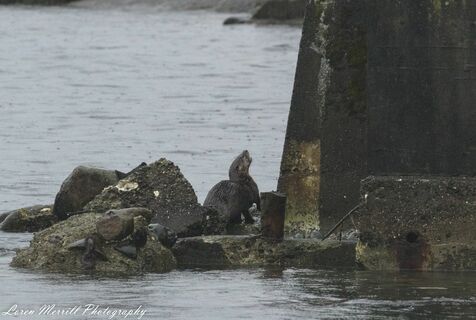 The aftermath: a river otter glares at the sky after a Bald Eagle appeared from nowhere to steal the otter's crab dinner. Ladysmith Harbor, BC. The aftermath: a river otter glares at the sky after a Bald Eagle appeared from nowhere to steal the otter's crab dinner. Ladysmith Harbor, BC. I mention at the start of this piece that the call of the eagle does not seem to befit a predator of their stature. The reality, however, is that bald eagles are extremely opportunistic. In addition to hunting for a range of prey items, they will consume carrion, forage at dumps for scraps (and associated rats and mice), and happily kleptoparasitize food from others. Their favorite targets here are the river otters. In our first week at the house, I was working at the table and out of the corner of my eye, noticed a large shape glide quickly past the window. I hopped up to see a bald eagle swooping down through the light rain, towards the rock outcropping at the stream mouth just to our east. The eagle was approaching the rocks from a very low angle, hidden from view somewhat by the seawall. When the large raptor got to the rocks, it banked sharply, reached out its talons and grabbed a large crab from one of the otters that had, until that moment, been enjoying its meal in peace. The startled otter looked up and around, and then quickly went back to eating in an attempt to stuff all the remaining scraps of food into its mouth before anyone else could come steal them. It repeatedly glanced skyward, as though expecting another raid from above at any moment. In the subsequent weeks, I have watched eagles swoop on the otters a few other times, most recently this morning. Today, however, there were three otters eating a large crab close together, and the eagle’s attempt did not yield any food. The eagle retreated to the top of a large Douglas fir to watch, and wait for another opportunity at an easy meal. Brief epilogue: These impressive raptors experienced dramatic population declines in the 1900s due to DDT use, hunting, and pollution, and were placed on the Endangered Species Act (ESA) in 1967. It is estimated that their numbers declined from perhaps half a million birds in the lower 48 in the 1800s, to 412 nesting pairs in the 1950s. Today, they are thriving in many areas of North America, due in large part to the ESA and the banning of DDT. The eagle’s delisting in the 90s was seen as a major success story for the ESA, and now people all over North America have the opportunity to watch these birds in action. In the next post, I cover an antagonistic interaction between a harlequin duck and a common merganser that is one of the funniest, most spiteful, and human episodes I have seen in birds. |
About the author:Loren grew up in the wilds of Boston, Massachusetts, and honed his natural history skills in the urban backyard. He attended Cornell University for his undergraduate degree in Natural Resources, and received his PhD in Ecology from the University of California, Santa Barbara. He has traveled extensively, and in the past few years has developed an affliction for wildlife photography. Archives:
|
